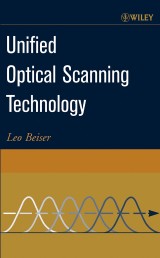Details

Unified Optical Scanning Technology
1. Aufl.
|
129,99 € |
|
| Verlag: | Wiley |
| Format: | |
| Veröffentl.: | 25.02.2005 |
| ISBN/EAN: | 9780471431411 |
| Sprache: | englisch |
| Anzahl Seiten: | 185 |
DRM-geschütztes eBook, Sie benötigen z.B. Adobe Digital Editions und eine Adobe ID zum Lesen.
Beschreibungen
Written by an award-winning leader in the field, this is a thoroughly integrated overview of the many facets and disciplines of optical scanning. Of particular utility to both practitioner and student are such features as: <ul> <li>An overview of the technology and unifying principles, including active and passive scanning, optical transfer, and system architecture</li> <li>In-depth chapters on scanning theory and processes, scanned resolution, scanner devices and techniques, and the control of scanner beam misplacemen</li> <li>A comprehensive review of the government-sponsored research of agile beam steering, now primed for commercial adaptation</li> <li>A unique focus on the Lagrange invariant and its revealing resolution invariant</li> </ul>
<p>Preface xi</p> <p>1 INTRODUCTION-TECHNOLOGY OVERVIEW AND UNIFYING PRINCIPLES 1</p> <p>1.1 Optical Scanning Characteristics and Disciplines 1</p> <p>1.2 Active and Passive Scanning 3</p> <p>1.3 Input, Output, and Remote Sensing Systems 8</p> <p>1.4 Optical and Resolution Invariants; Optical Transfer 9</p> <p>1.5 System Architecture 12</p> <p>2 SCANNING THEORY AND PROCESSES 19</p> <p>2.1 The Point Spread Function and Its Convolution 19</p> <p>2.2 Quantized or Digitized Scan 27</p> <p>2.3 Gaussian Beam Propagation 31</p> <p>2.4 Scanned Quality Criteria and the Modulation Transfer Function 37</p> <p>3 SCANNED RESOLUTION 45</p> <p>3.1 Influence and Significance of Scanned Resolution 45</p> <p>3.2 Aperture Shape Factor 50</p> <p>3.3 The Resolution Equation, the Resolution Invariant, and Beam Propagation 54</p> <p>3.4 Augmented Resolution 56</p> <p>3.5 Resolution in Passive and Remote Sensing Systems 61</p> <p>4 SCANNER DEVICES AND TECHNIQUES 63</p> <p>4.1 Scanner Technology Organization 63</p> <p>4.2 High-Inertia Scanning 65</p> <p>4.3 Rotating Polygons 65</p> <p>4.4 Holographic Scanners 85</p> <p>4.5 Oscillatory (Vibrational) Scanners 100</p> <p>4.6 Scanner-Lens Relationships 108</p> <p>4.7 Low-Inertia Scanning 112</p> <p>4.8 Acoustooptic Scanners 113</p> <p>4.9 Electrooptic (Gradient) Scanners 124</p> <p>4.10 Agile Beam Steering 128</p> <p>5 CONTROL OF SCANNER BEAM MISPLACEMENT 147</p> <p>5.1 Cross-Scan Error and Its Correction 148</p> <p>5.2 The Ghost Image and Its Elimination 155</p> <p>6 SUMMARY-MAJOR SCANNER CHARACTERISTICS 161</p> <p>6.1 Comparison of Major Scanner Types 164</p> <p>References 169</p> <p>Index 179</p>
"It will be of interest to graduate students as well as researchers and engineers." (<i>Optik 117</i>, 2006)
<b>LEO BEISER</b> retired recently as the president and research director of Leo Beiser Inc., a consulting and research company specializing in image and data scanning and recording for global clients including 3M, Agfa-Gevaert, Bell Labs, Boeing, Burroughs, Compugraphic, Kodak, Canon, General Electric, Polaroid, Scitex, and Xerox. Prior to that, as a staff researcher and project manager at CBS Laboratories, Autometric/Raytheon, Radio Receptor Corporation, and Polarad Electronics Corp., he pioneered formative advances in super-high resolution/speed image and data scanning and recording. An extensively published author and internationally renowned expert, Beiser has been recognized by his profession with numerous awards including the prestigious George W. Goddard Award from the International Society for Optical Engineering. Leo Beiser is Adjunct Professor in the Institute of Imaging Science, Polytechnic University, New York
A cohesive view of the expanding field of optical scanning, in a single compact volume <p>Optical scanning is a systematic sampling of spatial information, transforming images or data to or from a temporal signal for electronic processing. The field of optical information handling has been developing rapidly, with many of its classical forms being transformed in new and fascinating ways. For instance, the once-discrete fields of serial and parallel optical information transfer are evolving into new hybrid systems as researchers add the flexibility of optical scanning for greater operational advantage in data manipulation and transfer. Insight for such creative advancement is fostered with the unification of unapparent or secluded concepts.</p> <p>Written by an award-winning leader in the field, this is a thoroughly integrated overview of the many facets and disciplines of optical scanning. It brings together scanning theory, scanned resolution, deflection and modulation devices, optical transfer techniques, positional error analysis and control, system architecture, new research, and the unification of complementary or analogous processes, such as active and passive scanning systems.</p> <p>Of particular utility to both practitioner and student are such features as:</p> <ul> <li>An overview of the technology and unifying principles, including active and passive scanning, optical transfer, and system architecture</li> <li>In-depth chapters on scanning theory and processes, scanned resolution, scanner devices and techniques, and the control of scanner beam misplacement</li> <li>A comprehensive review of the government-sponsored research of agile beam steering, now primed for commercial adaptation</li> <li>A unique focus on the Lagrange invariant and its revealing resolution invariant</li> </ul>


















